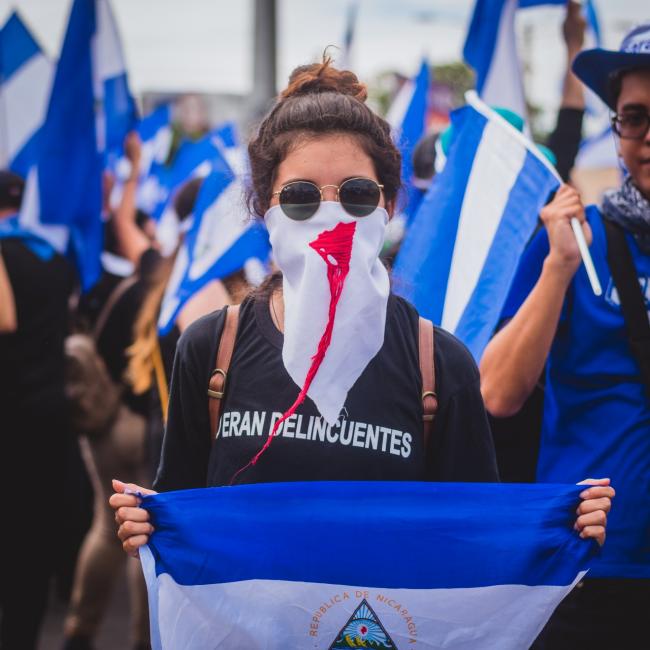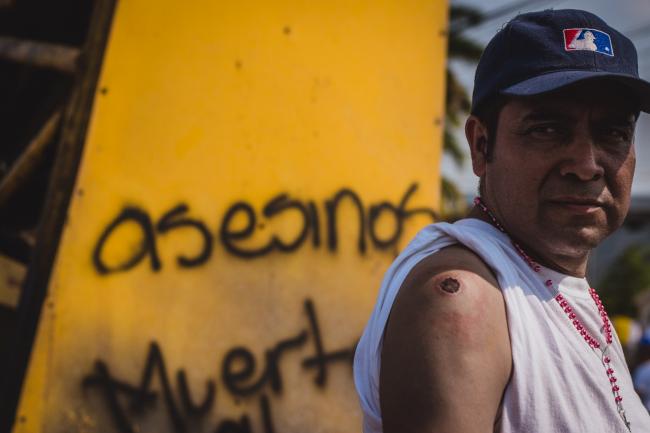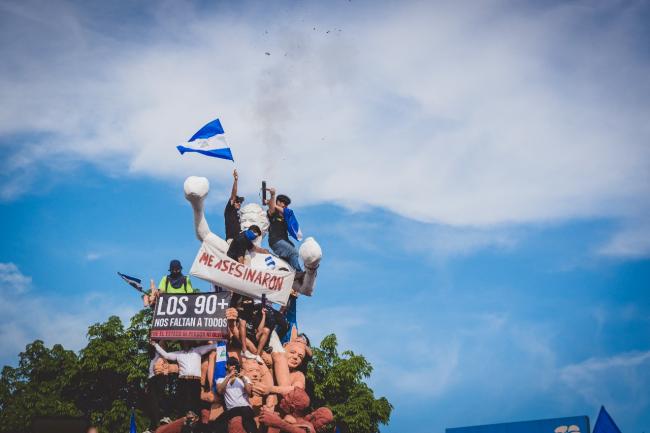
On March 16, 2019, Nicaraguans gathered for the country’s first mass protest in nearly six months. Neither the rain nor the phalanx of riot police dispatched along the route could deter those who had gathered with their blue and white flags to demand the release of over 600 political prisoners and the end of Daniel Ortega and Rosario Murillo’s government. Standing beneath an overpass on Managua’s main highway, the protesters began their march by singing the Nicaraguan national anthem.
By sundown, at least 160 individuals had been arrested, tossed in the back of police trucks, and transported to prison to be processed. Police released the protesters before daybreak, but not before one of them published a cell phone video in which the arrestees gleefully jumped around and chanted “whoever doesn’t get up is a sapo,” or a “toad,” the opposition’s moniker for government supporters.
This protest marked nearly a year since political unrest erupted in Nicaragua last April. Since then, a young generation of activists has been at the forefront of the anti-government mobilization. Drawing on international social movements, like Spain’s Indignados, and their nation’s own revolutionary history, the goal of many of the young protesters is not solely to change who holds political power but to transform how power is interpreted and exercised in the country.
The persistence and youth-led nature of the activism came as a surprise to many political observers. The post-revolutionary generation (those who came of age after the Sandinista revolution ended in 1990) have largely remained on the outskirts of formal politics. As 21-year old Madelaine Caracas reflects: “They called my generation the ‘depoliticized generation, the sleeping generation, the generation that was not going to do anything,’ so it was a surprise when we woke up in April.”
As Caracas says, before the last year of protests, “we didn’t feel comfortable in the political panorama.” Alienated from Nicaragua’s polarized government, young people had been more involved in art, social activism, religious movements, and NGOs. The protests have brought these disparate movements together to lay the bases for a more just and inclusive nation, she explains.
Their fight has grown increasingly international. Thousands of Nicaraguans have fled for Costa Rica, Spain, the United States, and other countries. Caracas herself has been living in exile in Costa Rica for nearly a year due to threats her family is facing in Nicaragua. She continues to carry out her responsibilities as a co-founder of the Coordinadora Universitaria por la Democracia y Justicia (University Coordinator for Democracy and Justice), and a member of the Articulación de Movimientos Sociales (Articulation of Social Movements). As part of the opposition’s strategy to cultivate international support to put an end to government repression, Caracas has testified about conditions in Nicaragua in front of foreign governments, human rights agencies, and international organizations like the United Nations and Organization of American States.

The supposed lack of political involvement of Caracas’ generation was a reaction to the governance style of both Ortega and his conservative opponents. Following the Sandinistas’ electoral loss in 1990, Ortega’s conservative successors framed “peace” as an apolitical practice. The Nicaraguans mobilized for war or production could return home and let the technocrats run the government. This strategy imploded amid massive corruption scandals that led to Ortega’s reelection in 2006.
However, Ortega’s second presidency did not mean a return to mass political participation. Instead his government has repressed opposition, which often comes from their Left. The ruling couple has shut down NGOs, booted international human rights agencies, and used groups like the Juventud Sandinista (Sandinista Youth) to harass and attack political opponents. The dissident Sandinista party, Movimiento Renavador Sandinista (MRS, Sandinista Renovation Movement) was barred from participating in elections after 2008. The opposition accuses the government of forcing poor Nicaraguans who benefit from the government’s bare-bones social programs, such as desperately needed medical care and construction material for houses, to participate in government rallies and vote the party line. The same goes for university students who receive government scholarships, critics have said.
In fact, today it is common to hear older Nicaraguans say “I’m a Sandinista, but not an Orteguista”—a rebuttal to Ortega’s efforts to monopolize claims to Sandinismo and its egalitarian, anti-imperial, and moralistic tenets, when many other revolutionaries are still alive and politically active. Indeed, some of the most vocal opponents of the Ortega governments are former Sandinistas, who have offered support and built alliances with Nicaragua’s new generation of activists based on their shared experiences. As Lea Guido, a leader of the Sandinista women’s movement in the 1970s and ‘80s, remembers, under Somoza, “it was a crime to be young, the Guardia captured people, like Orteguismo does today,” she says. “There is a terrible parallel, 44 years apart, a similar history of repression is being repeated.”
To be sure, while many Nicaraguans now taking to the streets are too young to remember the country’s battle against the U.S.-backed Somoza dictatorship in the 1970s, they have recycled strategies and slogans employed 50 years ago. In May 2018, Nicaraguan citizens pulled up paving stones to build makeshift barricades, blocking traffic and preventing the police and army from entering their neighborhoods. The opposition took on the dying words of a revolutionary poet (“¡Que se rinde tu madre!” or “let your mother surrender!”) as their battle cry. In December, the families and friends of imprisoned protesters launched a campaign for Christmas without Political Prisoners—echoing the same campaign used by Somoza’s opponents between 1969 and 1977.
“Because it’s a government that calls itself socialist and comes from a revolutionary history, it is difficult for people to understand that, really, there has not been revolution here for a long time,” anti-poverty activist Olga Valle points out. Unlike Caracas and many of their peers, Valle is not in exile, jail, or hiding, because her position as a spokesperson for an NGO requires her to keep a low public profile. Still, she is not precious with her words. “There is no revolutionary government; what we have is a government that is neoliberal, machista, classist, and racist.”
When protesters imagine a future after the uprising, they emphasize survival and collective well-being over sacrifice and loss. They are skeptical of violence and armed struggle. Today’s youth did not live through the Contra war and its 30,000 casualties, but they did grow up in its aftermath. Their goal is to find a political solution to Nicaragua’s crisis that will end the cycle of bloodshed, civil war, and political repression that has punctuated their national history.
In this context, young Nicaraguans—separate from official negotations—are pushing for an almost impossible demand: a top to bottom overhaul of Nicaraguan government and society. Activists like Valle envision a country based on economic equality, where the natural environment and human wellbeing are put before growth-centric development, education is socially and individually enriching, and gender-based violence does not shorten the lives of women and girls. Such ambitions have led some protesters to call this uprising a revolution. To translate protests and political negotiations into sustained social transformation, young activists will have to confront entrenched elites, internal conflicts about political ideologies and directions, and foreign interests or elites bent on using Nicaragua’s crisis to further their regional hegemony or define economic policy.

A New Generation Emerges
Today, young Nicaraguans are approaching political organizing in a markedly different way from their elders, trying to break the model of the caudillista strongman who dictates politics through a vertical structure. Organizations like the Coordinadora Universitaria por la Democracia y Justicia and the Articulación de Movimientos Sociales organize themselves horizontally, often through consensus models, and elect spokespeople rather than a singular leader. Activists describe their organizing in language shared with international social justice movements: “We talk about solidarity, collectivity,” Madeleine Caracas notes. “We say, ‘if the struggle is not intersectional, there will be no struggle.”
This is a difficult way to organize in a country where one can be arrested and imprisoned for assembling a dozen people for a meeting. However, these strategies reflect organizers’ dedication to changing more than who holds power. “Ortega has to go, but this won’t end the problem—it starts the problem,” Caracas says. “Because we have a state that is totally corrupt, we have a deformed state, a machista state, which is more concerned with economic power, and other forms of influence... How do we start to change this dynamic?”
Part of the answer has been to build or strengthen alliances with the other Nicaraguan social movements who have been challenging the status quo for the last 20 years. Young activists are working with Indigenous and Afro-descendant leaders from Nicaragua’s autonomous territories, who have long had a contentious relationship with the Ortega governments. They bolster the work of peasant leaders like Francisca Ramírez, an anti-canal activist. The Nicaraguan feminist movement, which includes many women who were guerrillas, ministers, and labor activists during the Sandinista revolution, has served as both inspiration and ally. Feminist activists have been at the forefront of protest and information campaigns, and feminist ideology has taught young activists to interrogate power, who holds it, and how it is exercised.
Negotiating a Path Forward
This interrogation of power is particularly important in light of the makeup of Alianza Cívica para la Justicia y Democracia (Civic Alliance for Justice and Democracy), the negotiating committee tasked with organizing a resolution to Nicaragua’s crisis with Ortega and Murillo’s government. The national dialogue process began last May, a month after the protests began. They have repeatedly stopped and restarted due to government intransigence and the opposition’s disagreements over strategy and demands.
As the journalist Manuel Orozco explains, negotiations have been asymmetrical, both in terms of the abuses suffered during the crisis versus the issues on the agenda, and due to the “limited involvement of students, peasants, and other civil society groups, including the opposition that makes up the Unidad Azul y Blanco (Blue and White National Unity).” The primary negotiator for the Alianza Civica is the president of Nicaragua’s most influential business chamber, which is a cause for concern among justice-minded activists. “We know how party leadership and the privileged act,” Olga Valle says. “I don’t know if I would put much hope there.”
Young people try to hold negotiators accountable by taking to the streets. The Unidad Nacional Azul y Blanco defied the government’s prohibition on unauthorized marches and convened the March 16 protests because students in the Coordinadora Universitaria objected to the Alianza’s decision to restart negotiations despite the government dragging its feet on the release of political prisoners. These activists insist that the country cannot move forward while hundreds of Nicaraguans remain unjustly incarcerated.

Political prisoners are also at the forefront of protest and negotiation because the opposition has centered human rights in their strategy for making political demands. By cataloguing human rights abuses—disproportionate use of force, press censorship, arbitrary and illegal detention, the use of torture (including sexual violence) in prisons—some Nicaraguan activists hope to force foreign governments to isolate Ortega and facilitate his removal.
The reliance by some of these activists on international organizations and foreign governments pose challenges for the opposition movement. Sovereignty and anti-imperialism, the rallying cries of the Sandinista revolution, are almost absent from the vocabulary of the opposition today. Instead, this is the language used by the Ortega government, which characterizes the opposition as internationally-sponsored coup plotters, and international human rights observers as forms of imperialist intervention. In fact, some young activists, as well as senior negotiators in the Alianza Cívica, have pushed the U.S. government to apply Magnitsky sanctions to Ortega and his coconspirators and cheered the passage of the Nica Act. Following visits from European diplomats in January 2019, the European Union approved a resolution encouraging member states to apply sanctions against high ranking members of the Sandinistas.
When asked if reliance on foreign nations and institutions worried activists, Caracas recognized that there is “significant concern about who helps, why they are helping, and how much influence they might have in decisions, and the future, and what could happen.” Falling into the trap of foreign interests who want to determine the nation’s future, Caracas continues, can only be avoided through “organization and clear political proposals.”
This is perhaps, the opposition’s weak spot. Both youth activists and the Alianza’s negotiating team are focused on bringing about political transition, and have given less attention to what comes next. Their demands include moving up elections scheduled for 2021 and ensuring they are free and fair; the liberation of political prisoners; both those who have been tried and those awaiting trial; the disarmament of irregular forces (para-militaries and para-police groups); and the right of return for exiled Nicaraguans.
These priorities reflect the depth of Nicaragua’s crisis, but they are a far cry from bringing about the changes that young activists want to see. According to Valle, “there still isn’t clarity on a plan for the country.” Without a plan for moving forward, “It is possible that [Ortega’s] exit won’t be the most beneficial for Nicaragua.” Despite their misgivings about who might replace Ortega, immediate concerns come first. “It would be beneficial if they stopped killing and repressing us.”
Indeed, aside from the over 300 Nicaraguans killed since the protests began, few individuals have experienced this repression more acutely than the country’s estimated 830 political prisoners (including between 150 and 200 released to house arrest). Following the protests on March 16, 2019, the Ortega-Murillo government promised to release all political prisoners within 90 days. This was an important step forward for an administration that has refused to recognize the existence of political prisoners—it categorizes them as common criminals or anti-state terrorists. For those who have been fighting to free their friends and family for months, 90 days feels like an eternity.
In response to the announcement a newly formed organization, the Union of Nicaraguan Political Prisoners, published a declaration imploring Nicaraguans not to “surrender before repression” or “allow others to decide our lives and our future.” The ex-prisoners signed off with a now ubiquitous slogan: Patria Libre y Vivir, “A Free Country and Life!” This reconfiguration of Latin American revolutionaries’ classic motto Patria Libre o Morir, “A Free Country or Death,” embodies contemporary protests’ connection to their insurgent past and a new vision for the future.
Beyond the negotiating table, Nicaraguans from the urbanized Pacific coast are hearing the demands of people from the often-neglected Atlantic coast territories, and women are affirming their place as political leaders. Last year’s uprising has shown that it is a people, not a party leader, who represent and carry forth the spirit of revolution.
Sarah Sklaw is a Ph.D. candidate at NYU, where she is writing a dissertation on gender and international development projects in Nicaragua from the 1970s to the 1990s. She is also involved in activism around migrant rights and leads tours about New York City history. Follow her on Twitter at @notsklawface
Photos by Mauricio Valenzuela.

